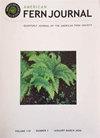Comparative Micromorphology and Ultrastructure of Resurrection and Non-resurrection Selaginella Species
IF 0.9
4区 生物学
Q4 PLANT SCIENCES
引用次数: 1
Abstract
Abstract. Most species in the genus Selaginella (Selaginellaceae) are susceptible to desiccation, while a few species are able to withstand the extreme desiccation, recover metabolic functioning, and grow rapidly after rehydration. However, there is limited information about the anatomical features of the resurrection species in Selaginella. In the present study, we compared the microphyll micromorphology and ultrastructure of two resurrection species (S. pulvinata and S. sanguinolenta), and two non-resurrection species (S. kraussiana and S. chrysocaulos). Compared with the two non-resurrection species, the two resurrection species had most of their stomata distributed on the adaxial surface of microphylls that were tightly attached to stems, and possessed smaller and thicker microphylls, smaller stomatal size, higher stomatal density, thicker epidermal cell walls, more chloroplasts, and denser cytoplasm. These micromorphological and ultrastructural features of the two resurrection species were beneficial in reducing the transpiration and dehydration damage and could be considered as ecological adaptations to xeric environments.复活与非复活卷柏种的显微形态和超微结构比较
摘要卷柏属(Selaginellaceae)中大多数种对干燥敏感,但少数种能够承受极端干燥,恢复代谢功能,补液后生长迅速。然而,关于卷柏属复活种的解剖特征信息有限。在本研究中,我们比较了两种复活种(S. pulvinata和S. sanguinolenta)和两种非复活种(S. kraussiana和S. chrysocaulos)的微藻微形态和超微结构。与未复活种相比,复活种的气孔大部分分布在紧贴茎的小叶正面,且小叶更小、更厚、气孔尺寸更小、气孔密度更高、表皮细胞壁更厚、叶绿体更多、细胞质更致密。这些微形态和超微结构特征有利于减少蒸腾和脱水损害,可以认为是对干旱环境的生态适应。
本文章由计算机程序翻译,如有差异,请以英文原文为准。
求助全文
约1分钟内获得全文
求助全文
来源期刊

American Fern Journal
生物-植物科学
CiteScore
1.20
自引率
0.00%
发文量
28
审稿时长
6 months
期刊介绍:
The American Fern Journal is a peer-reviewed journal focused on the biology of ferns and lycophytes.
 求助内容:
求助内容: 应助结果提醒方式:
应助结果提醒方式:


